Micron M500DC 800 GB SSD Review: Cloud And Web 2.0 Storage
Building on the desktop-oriented M500, Micron is announcing its enterprise-focused M500DC. We got a chance to run the 800 GB model through an updated test suite to gauge whether this Marvell-powered SSD keeps up with the best-known enterprise solutions.
A Look Inside Micron's M500DC
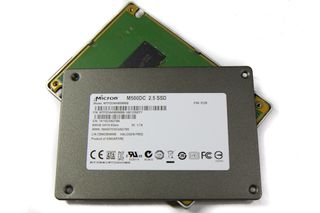
Though the M500DC shares its architecture with the M500, opening up the new SSD's chassis shows that they're actually quite different. The first thing you'll notice is how empty the PCB appears. There's so much room, in fact, that Micron left what we assume are debug headers across one side of the board.
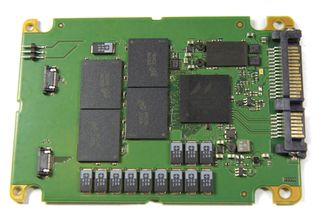
Micron has so much available space because the M500DC employs high-density NAND. The 800 GB model has 1024 GB of 20 nm MLC flash spread across eight packages. It's not of the eMLC variety. But still, Micron bins it specifically for more enterprise-oriented products.
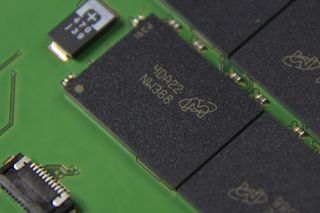
The M500DC and M500 have the same type of NAND in common. However, when you open up an M500, you'll see all eight packages on one side of the PCB. The M500DC sports four per side. Each package contains eight dies, totally 1 Tb (128 GB) of capacity. Freeing up extra room allows Micron to also ship the M500DC in a 1.8" form-factor, in addition to the 2.5" drive we're reviewing. We didn't have a chance to benchmark the 1.8" model, however, you can see how the components would fit in a 1.8" footprint.
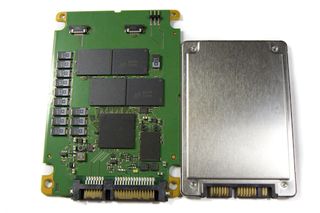
If you looked closely at the specifications on the previous page, two data points probably jumped out at you. First, the 800 GB M500DC has identical write endurance and lower random write performance compared to the 480 GB model. How is that possible? The more NAND your drive includes, the more flash there is to spread write amplification across and the higher endurance should be. It's just that simple.
When we opened the 800 GB model, we encountered the expected 1024 GB of NAND. So, what's going on with the other capacities to explain the difference? It turns out the the smaller drives include nearly double the amount of over-provisioning compared to Micron's 800 GB version. The 480 GB M500DC comes equipped with six packages, for instance, instead of the four you'd expect, yielding a raw total of 768 GB. As we know, the more NAND the controller has to work with, the more efficiently it can apply its software algorithms.
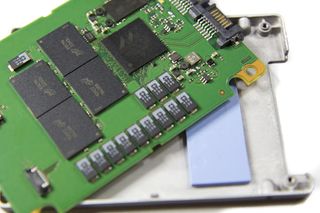
Micron uses the same venerable Marvell 9187 that appeared on its M500, and heat is removed from it through thermal pads attached to the chassis. Of course, Micron applies its suite of enterprise-oriented firmware features (XPERT), which takes NAND management to a level appropriate for that market. I discussed the features at length in Micron P400m SSD Review: High Endurance MLC Is Here To Stay, but here are the highlights:
- Redundant array of independent NAND (RAIN): An architecture that essentially provides device-integrated algorithms that are RAID 5 across the flash channels.
- Advanced Read Mangement/Optimized Read (ARM/OR): This feature uses DSP algorithms to optimize NAND read and write locations.
- DataSAFE: A data path protection mechanism that ensures all information is transferred correctly through the SSD structures.
- Physical Power-Loss Protection: This feature uses on-board capacitors to continually store power for emergency use.
- Reduced Command Access Latency (ReCAL): Utilizes well-managed background operations for quicker response times.
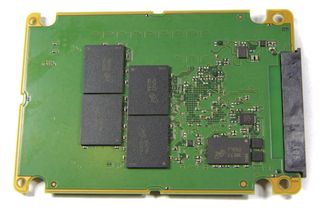
Additionally, the M500DC sports two 512 MB DDR3 DRAM packages, one on each side, yielding a fairly standard 1 MB per gigabyte DRAM to NAND ratio.
Stay on the Cutting Edge
Join the experts who read Tom's Hardware for the inside track on enthusiast PC tech news — and have for over 25 years. We'll send breaking news and in-depth reviews of CPUs, GPUs, AI, maker hardware and more straight to your inbox.
Finally, the top of board is populated with 12 capacitors used for power-loss protection.
Current page: A Look Inside Micron's M500DC
Prev Page Bridging The Gap Between Consumer And Enterprise Storage Next Page How We Test Micron's M500DC-
ParrLeyne Good article/review!Reply
Only one _small_ problem. According to the Micron product page (http://www.micron.com/products/solid-state-storage/enterprise-sata-ssd/m500dc-enterprise-sata-ssd) the M500DC is a SATA device, not SAS! -
tripleX The author obviously does not understand the subject matter. SAS lumped in with SATA? read-centric SSD isnt meant for read workloads? etc. numerous errors, too many to list.Reply -
tripleX Author does not understand what "corner case" is. corner case testing? are you doing lab validation work?Reply -
drewriley In SSD testing, it is common to call the mix in testing between read/write and random/sequential as '4 corner' or 'corner case' testing. And yes, this is lab verification work, that is kind of the point of the review. Also, SAS and SATA do compete for applications. The point was to put different product that had similar specifications against one another.Reply -
tripleX Reply13279486 said:In SSD testing, it is common to call the mix in testing between read/write and random/sequential as '4 corner' or 'corner case' testing. And yes, this is lab verification work, that is kind of the point of the review. Also, SAS and SATA do compete for applications. The point was to put different product that had similar specifications against one another.
The fact you are claiming this is anything even remotely near lab validation exposes your tremendous lack of knowledge on the subject.
No one refers to 4-corner testing as corner case testing. One link to a reputable site that does so? Instead of arguing an indefensible point you should be attempting to learn exactly what corner case means. Most would have had the good sense to do that before posting.
SAS v SATA is like Formula 1 compared to Go-Karts. Another example of your lack of understanding. SAS is meant for users who require certain features, and the price demands that users are aware of those features. They do not compete against each other, they are two entirely different classes of hardware.
-
tripleX The fact you are claiming this is anything even remotely near lab validation exposes your tremendous lack of knowledge on the subject.Reply
No one refers to 4-corner testing as corner case testing. One link to a reputable site that does so? Instead of arguing an indefensible point you should be attempting to learn exactly what corner case means. Most would have had the good sense to do that before posting.
SAS v SATA is like Formula 1 compared to Go-Karts. Another example of your lack of understanding. SAS is meant for users who require certain features, and the price demands that users are aware of those features. They do not compete against each other, they are two entirely different classes of hardware.
Most Popular

